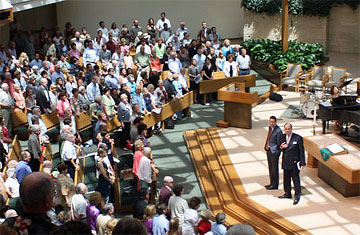Yesterday I began telling the story of how the Internet impacted the recent calling of Rich Kannwischer as the next senior pastor of St. Andrew’s Presbyterian Church in Newport Beach, California.
 Now, for the rest of the story. Last Sunday there was a congregational meeting at St. Andrew’s to vote on the recommendation of the nominating committee to call Rich to the church. Usually this sort of thing is a slam dunk. But, in the case of St. Andrew’s, the situation was much messier because one of the top candidates for the position was an associate pastor at St. Andrew’s who has a large following in the congregation. It was well known in the congregation that this other man had been in the running, but he was not the final choice of the nominating committee. This meant that the vote to call Rich would surely be significantly split in the congregation. (Presbyterian congregations almost never know who other potential candidates were. The process at St. Andrew’s, involving a short-term co-pastorate and an internal candidate, was unusual in the extreme. Photo: John Huffman and Rich Kannwischer in front of the congregation at St. Andrew’s. Photo from the nominating committee blog. )
Now, for the rest of the story. Last Sunday there was a congregational meeting at St. Andrew’s to vote on the recommendation of the nominating committee to call Rich to the church. Usually this sort of thing is a slam dunk. But, in the case of St. Andrew’s, the situation was much messier because one of the top candidates for the position was an associate pastor at St. Andrew’s who has a large following in the congregation. It was well known in the congregation that this other man had been in the running, but he was not the final choice of the nominating committee. This meant that the vote to call Rich would surely be significantly split in the congregation. (Presbyterian congregations almost never know who other potential candidates were. The process at St. Andrew’s, involving a short-term co-pastorate and an internal candidate, was unusual in the extreme. Photo: John Huffman and Rich Kannwischer in front of the congregation at St. Andrew’s. Photo from the nominating committee blog. )
During the early afternoon of last Sunday, I was dying to know what was happening in the congregational meeting at St. Andrew’s, but I was riding in a car that was speeding through the Texas countryside on Interstate 10. What did I do? Using my iPhone, I visited a Twitter search website, and searched for “Kannwischer.” In a few moments I was following two Twitterers who were members of St. Andrew’s. There were present in the congregational meeting and putting up regular tweets on the meeting’s progress. Sitting in a car in the middle of nowhere in Texas, and there’s a lot of nowhere in Texas, I was getting frequent, live reports of a congregational meeting in Southern California. Within seconds of the announcement of the vote, I knew that Rich had obtained a substantial majority. Then, a few moments later, I knew that he had accepted the call and was introduced as the new pastor at St. Andrew’s.
Like I said, we’re not in Kansas anymore. Not by a longshot.
How should we Presbyterians respond to the impact of the Internet on our process of calling new pastors? I can imagine one type of response that laments the behavior I’ve been chronicling and seeks to limit it. I can envision a church saying to its people, “Do not communicate about our pastoral conadidate outside of this church body. Don’t email people or Twitter or blog or anything. Plus, there will be no use of Twitter or Facebook or other social media in any congregational meeting.” This would be an attempt to uphold the past and its benefits. But I am positive that it would eventually fail. The reactive “we must clamp down” reminds me of what we’re seeing in China with regard to the Internet. But the world is just too flat to prevent electronic communication. If a church tries to keep people from communicating via the Internet, it will fail, and its members will feel as if they’re living under a repressive regime. Not a good plan.
The other option for Presbyterians (and other churches in a similar situation) is to think creatively about how best to manage communication outside of Kansas. My guess is that it will be harder and harder for pastors to keep their possible new calls hidden from their existing congregations until they are final. This may mean that both potential pastors and potential new churches will need to work harder, both at discernment, and in using new ways of communication to build support for a pastoral candidate. St. Andrew’s Presbyterian Church, for example, produced a marvelous brochure in support of Rich, and the nominating committee had a very helpful blog with lots of pertinent information. Other churches would do well to imitate the example of St. Andrew’s. (Of course I realize that not all churches have the resources of St. Andrew’s. But it takes relatively little money to make good use of the Internet. A blog, for example, can cost a mere $5.00 a month and is very easy to do.)
Looking at the bigger picture, I think the example of St. Andrew’s points to the need for greater openness in communication, even when it comes to matters that we might prefer to keep quite. For example, one of the best pieces of communication on the blog of the St. Andrew’s nominating committee was a letter to the congregation that spoke with unusual candor and tenderness about the internal candidate who was not called as pastor. This was a bold and wise move by the nominating committee, which, in the end, surely contributed to the church’s ultimate vote. The fact that we don’t live in Kansas anymore will challenge people in church leadership to communicate in new ways. This will be messy at times, but it can also lead to greater health and trust in churches. Clamping down on communication, will, on the contrary, lead to less health and less trust.
Of course when Dorothy Gale realized that she wasn’t in Kansas anymore, she spent the rest of a long movie trying to get back to what was familiar and comfortable. She wanted to go home. Eventually she made it. I expect there will be some church leaders who share Dorothy’s mentality. But we have no Ruby Slippers to turn back the clock. Kansas is gone for good. There is no more home. Technology in general and the Internet in particular have forever transported our home to Oz. Our challenge and opportunity is to discover how to be the church in a new land of open, free, and sometimes frustratingly uncontrollable communication.
I close with a commercial. If you’re looking for help in learning how thrive in Oz, join me at the Christian Web Conference at Biola University on September 11-12, 2009. You’ll be glad you did.
More from Beliefnet and our partners

